The End of Tokyo Homes
Every couple of weeks, as I ride my bike to the station, I come across a home split open. Along the way, I see stately traditional homes chewed up by backhoes, spit into trucks and hauled away. I risk being late to work to watch walls and posts topple, roofs collapse, concrete foundations get jackhammered as another home is broken to pieces small enough to haul away on a flatbed. I feel like I’m witnessing a crime.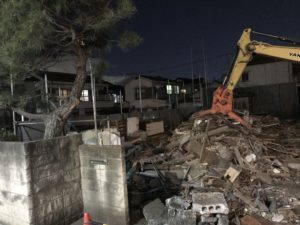
All I’m really witnessing is the Tokyo process of re-dividing land. Old homes with gardens are too much trouble for young people, so they’re sold off, ripped down and the lot subdivided. The economics doesn’t interest me. It’s the process I can’t take my eyes off of.
Wall after wall is smashed and splintered and the guts of houses I’d ridden by for years are exposed. You can see what was long hidden—the inner stage for the dramas of bedroom and kitchen, the relaxation of tatami and bath, the secrets of closet and toilet. All are left hanging out like morning wash for any passerby to ogle.
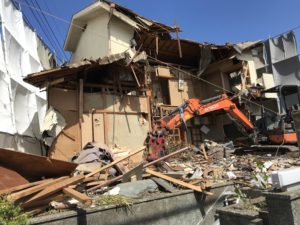
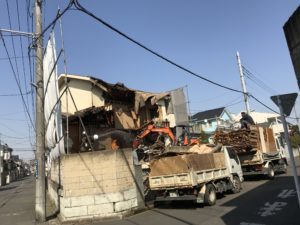
It’s mesmerizing to witness the interior become exterior, the construction put on rewind and the walls that protected one family’s world stripped away. It’s hard to not want to see the end, violent as it is, of something so private and special. The creaking and shredding of walls and staircases and balconies and floors seems to be the last noises of a generational home.
In one Toshiro Mifune film, he gets revenge on a rice-hoarding landlord by taking out the central pillar of his storehouse with a single swing of his sword. The roof and walls collapse and starving peasants surge in. I laughed the first time I saw that film, not believing it. But now I know it’s true. It’s not one sword cut, of course. It is a week of backhoe thrusts, a bit of yanking and tearing, along with some well-aimed hammering. And it’s over.
Most of the glass windows and wire guts have been removed before the real action gets underway. Pictures, decorations, furniture, tatami mats are left in place, not to mention toilets, plumbing and bathtubs, the metal of which crumples up like silver paper. The tile roof, which is heavy and dangerous, and no doubt a pain to clean up if shattered, is tossed hand to hand down to the truck. Once all that’s gone, a Japanese home is not much more than wood and memories.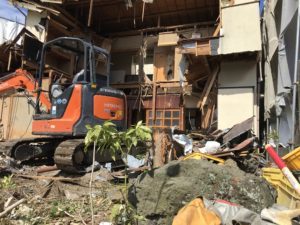
As other Japanese hurry past, I rationalize my staring as cultural study. It is rare in Tokyo to go into other people’s homes. Entertaining is done outside, at bars or restaurants, rarely at home. I’ve been to one or two of my Japanese colleagues’ homes, but not many. Looking inside homes or offices from the train lets you see for a passing second. But you never get to fully indulge your eyes, or imagination.
To answer Robert Frost’s famous poem, something there is that doesn’t like walls down, too, that doesn’t want the inside exposed, the past splayed open. It’s like seeing time reversed, a bed sheet pulled back, a door opened too soon. It’s obscene in a way. People stare at me taking photos of the destruction, silently scolding me, I guess, that I should have more respect for the dead.
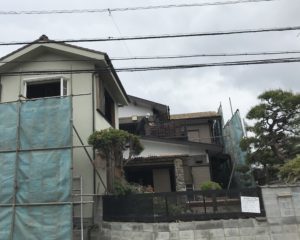
But I do have respect. It’s just that it’s fascinating to watch the backhoe attachment eating its way through the house like a giant, metal termite. In collapse, the homes appear to be nothing more than dust and sawdust held together by some old spell. There is so much dust one worker sprays water to keep it from drifting around the neighborhood. The unique smell that every home has from cooking, bodies, pets, sprays and—in older homes—mold, is lifted into the air and disperses.
I’m always intrigued by the skill, and daring, of the workers. The driver works the controls like a jazz drummer, moving forward to crunch through a section of wood, backing off to let it drop, surging forward to pick it up, all the while shifting the wheel tracks. With the pincher teeth, they can pick up a strong beam to whack down ceilings, buckle a staircase and bust through an inner wall. The stackers set wood boards and beams on the trucks like a too-easy puzzle.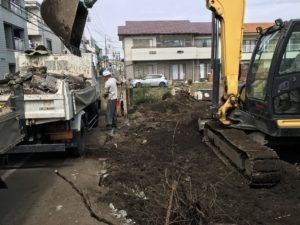
One rainy morning, I asked a team of two stackers and one backhoe operator if it was OK to take photos. They laughed and waved OK. As I took photos, the backhoe operator smiled from inside the cab and showed off by delicately picking up a single board and placing it precisely on top of the stack. In fact, they use only as much force as needed, moving everything meticulously, and delicately.
I asked the guy in charge of stacking the wood how long one home took. He told me most homes took about a week. The materials had to be carefully separated into insulation, metal, concrete, and wood. The tatami mats are often slipped under the treads for traction. I asked where he recycled everything, wondering what you’d get for all the materials. He looked confused. “It’s all gomi (trash),” he told me, gesturing from atop a neat pile of wood on the truck bed. Then he got back to work.
It must be a sad job, I felt, snagging abandoned furniture, bathtubs, sinks, fixtures and the occasional abandoned painting. I wondered whether the workers imagined, as they worked, the conversations, laughs and cries, the arguments, celebrations, dinners, baths and expressions of love that must have taken place inside that home. I wanted to ask them how they felt, what they’d seen, or if it was just a job. But I didn’t ask. I maybe didn’t want to know.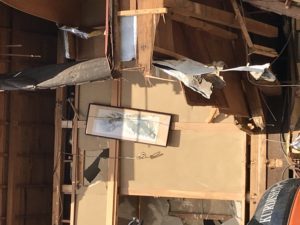
Instead, I rode off on my bike wondering if once the last board of wood is stacked, the dirt packed in place and the public road hosed down, whether anything remained to remember the lives lived there. It couldn’t all be gomi. But in Tokyo, it’s the land that holds value, not the past lives or the old buildings.
After that I always ride by in the following weeks, glancing anxiously at the dirt, waiting for signs of the groundbreaking ceremony. I’ve never chanced on an actual ceremony, in which a Shinto priest sets up a ring of bamboo, rope and washi paper, with a symbolic wooden hoe, sacred sakaki branches, and other offerings. Those are taken away after the ground is purified and spiritually readied.
But left behind always is what looks to me to be a sprig of rice in a small mound of dirt, from which another home, another set of lives, will grow there again.
Michael Pronko, July 11, 2019



